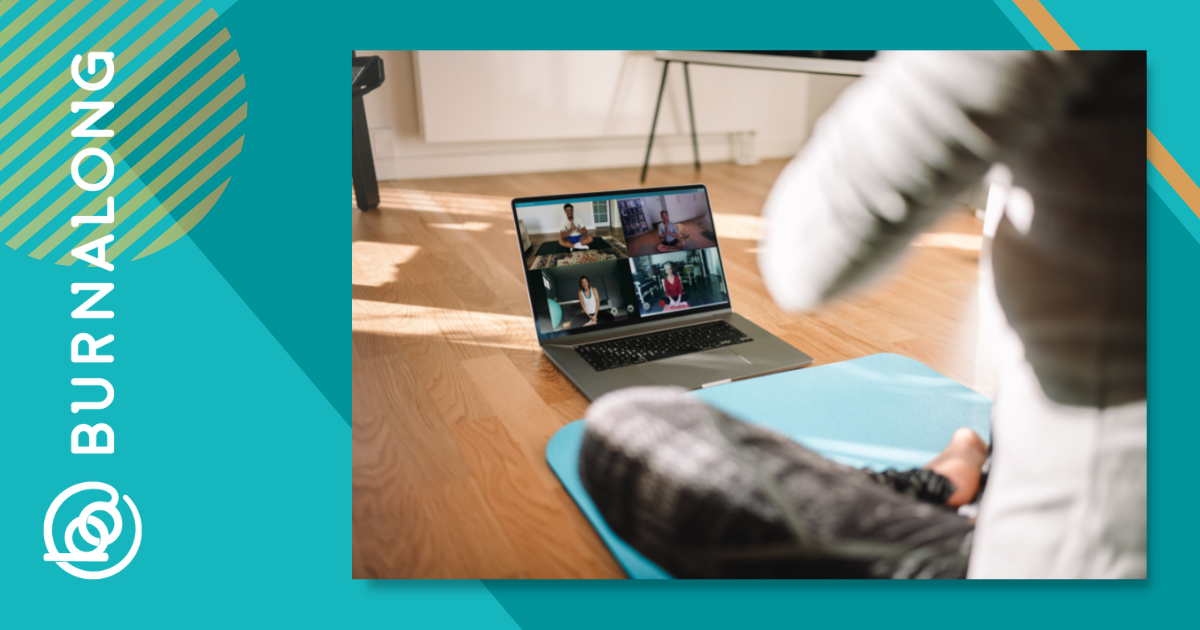Wellness through mindfulness is becoming an increasingly popular topic for people of all walks of life. In fact, meditation is now the second most popular mind and body practice in the US, just behind yoga.
While there are numerous benefits to practicing mindfulness, a key outcome is often a reduction of stress. Managing or reducing stress has long been a key concern for HR leaders and professionals. Prior to the pandemic, 83 percent of Americans reported suffering from work-related stress. It hasn’t gotten any better with organizations phasing in new work models and adjusting to an exhausted workforce.
At its core, mindfulness is about focusing on one thing at a time. It is a practice of self-care – caring for your own health and wellness – so that you can effectively support others.
Practicing mindfulness is much easier said than done, however. In this article, based on a recent conversation with Megan Delp, a Burnalong instructor plus marriage and family therapist, we are going to discover the path to achieving wellness through mindfulness and overcoming resistance factors. Most importantly, we will explore how to implement mindfulness in your personal habits and corporate wellness programs so you–and your teams–can reap the benefits.
Check out our webinar with mental health experts Dr. Jess Williams and Bianca Coleman for more tangible suggestions on supporting employee mental health.
Mindfulness Myths
- Myth Number 1 – Mindfulness is connected to religious practices or yoga.
While spirituality and yoga practice do fall under the mindfulness umbrella, they are not reliant on one another for success. Mindfulness is simply about training the mind to focus on one thing at a time, and that thing can be anything at all.
- Myth Number 2 – Mindfulness requires large chunks of time to be effective.
When first getting started, just 30 seconds of meditation can be effective. Gradual increases become easier, just like working increasing reps and weights in a new workout regimen. With practice and consistency, longer stretches of physical exercise become easier. It’s the same concept when it comes to exercising your brain.
- Myth Number 3 – Mindfulness is boring!
Mindfulness gets a bad rap and is often equated to “blanking” the mind, but this is not the case at all. Mindfulness can be used in any activity you’re already doing! Listening to music, taking a walk, working at your desk – whatever you want it to be. Mindfulness is about focusing in and letting your brain take a break from distractions.
The concept of mindfulness is pretty easy. It is the practice itself that can be more difficult. It can be really hard to allow ourselves moments of simplicity and to stay engaged in only the thing we’re currently doing.
Mindfulness allows us to hit pause on the external noise and be present in the place we are now. Let’s dive into some tips for getting started and ways to use it in your own life and imbue into your corporate mindfulness programs.
Mindfulness in Everyday Life and Work
Can you remember the last song you listened to from start to finish? This might seem like an odd question but it has been proven effective in practicing mindfulness. Start with a song that you love or a familiar song from childhood. Sit quietly without distractions. Listen to the lyrics and focus on the individual instruments or voices throughout the entire song.
How about practicing mindfulness in your next conversation or meeting? Instead of half-listening or becoming distracted by your phone or emails, focus on making eye contact, listening intently, paying attention to the way you are reacting physically with head nods and smiles. Keep your thoughts and body in the moment. An added benefit here is not only for yourself but for the other person receiving your focused attention. It might even lead to more efficient conclusions!
Even as you read this article, you can practice mindfulness. Let’s give it a shot right now. Turn off your work notifications. Turn off your phone and place it to the side. Turn off the background music. Let your hands rest in your lap, focusing your attention on the screen. Read these words with intention.
If you notice your brain becoming distracted or getting bored, pull yourself back to this present place. Notice how quickly you might want to look away or quickly pop over to check your phone or email. Keep coming back to these words on the screen.
Interested in some additional mindfulness techniques or creating a team challenge to take mindfulness minutes throughout the week? Check out our mindfulness classes on the Burnalong platform.
Getting Grounded
As we practiced a moment ago, the first step into mindfulness is about noticing, pulling back, and refocusing. In fact, we train our brains like a muscle. One of the easiest and most common techniques for getting started in mindfulness is called a grounding exercise.
This is perfect for when you are rushing from meeting to meeting, can’t focus, and your mind is spinning. Or, you’re so overwhelmed that it’s hard to know what step to take next. You could also incorporate this wellness habit into your workday. Try taking the first few moments of a meeting to lead your team through this exercise, or a quick Burnalong mindfulness class, so that everyone starts the meeting with refreshed focus. Here is what you do.
Grounding Exercise
- Look around yourself and find 5 items you can physically see in your environment. Be sure to name and acknowledge those five things. Notice their color and shape. Notice how you feel about those 5 items being in your environment.
- Now identify 4 things you can physically feel. It might be your lips pressing together or the clothing you’re wearing.
- Next, listen for 3 things you can hear in your office. The hum of the vent, the voice of coworkers next door, the ticking of your watch.
- Identify 2 things you can smell – a candle on your desk, the fresh air from the window.
- Lastly, identify 1 thing you can taste. Maybe it’s lunch from earlier or the cold coffee on your desk.
That’s it. It seems simple, but this exercise is helpful for anxiety, confusion, and stress. By reconnecting you to your body, your brain hits pause for a moment and naturally resets.
Applying Mindfulness to Corporate Wellness Programs
While the concept of mindfulness can seem simple, it can be extremely challenging, particularly for hybrid or fully remote teams, to exercise these intentional moments throughout their workday. Deliverables and back-to-back meetings can make it feel like there isn’t a moment to spare; we get it!
However, the benefits of mindfulness for your teams, both individually and collectively, can make a marked difference in their connection with each other, their overall health and wellness, and their perception of your company culture. With 60 percent of employees stating they want their workplaces to provide wellness benefits, it is also something future talent will be looking for in an employer.
Investing in the wellness of your workforce, with an expanded definition of benefits that includes more holistic support of an employee’s wellbeing, will result in increased engagement, improve retainment and recruitment, plus reduce healthcare costs. Not to mention an increase in productivity and workplace satisfaction.
At Burnalong, over the past year, we’ve seen an increase in classes completed within our specialty programming which includes mindfulness, meditation, mental health, and stress management. In fact, specialty programming makes up 39 percent of our overall completed classes on our platform. Employees are looking for support.
To find out how Burnalong can support you, and your workforce, schedule a demo today or reach out to our customer service so we can brainstorm solutions with you.





